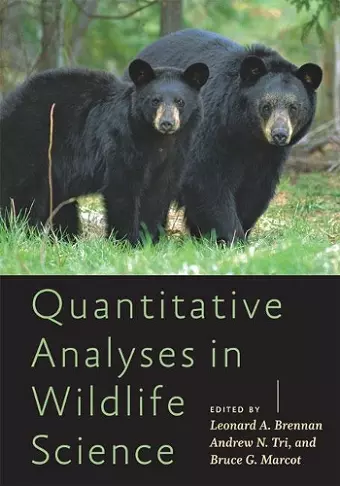Quantitative Analyses in Wildlife Science
A guide to statistical methods for wildlife analysis
Leonard A Brennan editor Bruce G Marcot editor Andrew N Tri editor
Format:Hardback
Publisher:Johns Hopkins University Press
Published:30th Nov '19
Currently unavailable, and unfortunately no date known when it will be back

This essential guide equips wildlife scientists with quantitative methods to enhance their analysis and decision-making in various ecological contexts.
This book serves as an authoritative guide to quantitative methods that assist wildlife scientists in enhancing their analysis and decision-making processes. Over the past fifty years, the field of wildlife science has increasingly embraced quantitative approaches. However, many professionals in this area may not have formal training in biometrics, computer modeling, or mathematics, making the vast array of available analytical techniques appear daunting. This practical resource is designed to bridge that gap, offering insights for both students and seasoned professionals on how to effectively apply quantitative methods in their fieldwork.
Quantitative Analyses in Wildlife Science covers the most commonly used contemporary techniques for analyzing wildlife populations and habitats. The book is organized into five main sections: general statistical methods, demographic estimation, dynamic process modeling, analysis of spatially based data, and numerical methods. Each section delves into various topics, including population estimation, growth trend predictions, and migration studies. The authors present fresh data on critical issues such as sustainable harvesting, invasive species control, and species reintroduction efforts.
Contributions from leading researchers in wildlife science ensure that each chapter not only addresses the structure of data relevant to specific analytical techniques but also discusses the inherent variation within those data sets. By providing conceptual and quantitative overviews of modern analytical methods, Quantitative Analyses in Wildlife Science is an essential resource for anyone engaged in conservation research or wildlife policy, making it a valuable addition to the library of every wildlife professional.
This is primarily a book for students and working wildlife management professionals; however that is not to say that it is, or should be, outside the realm of consideration by those with a sincere interest in how wildlife researchers collect and interpret data. As so many aspects of contemporary wildlife conservation revolve around what the number are, how they were collected, and how they are interpreted, most anyone with a serious interest in wildlife conservation would do well to at least understand how the metaphorical sausage is made – even if they're not making it themselves. To that end, this is most certainly the book from which to best acquire such an understanding.
—Johannes E. Riutta, The Well-Read Naturalist
- Short-listed for Wildlife Society Outstanding Edited Book 2020 (United States)
ISBN: 9781421431079
Dimensions: 254mm x 178mm x 29mm
Weight: 862g
344 pages